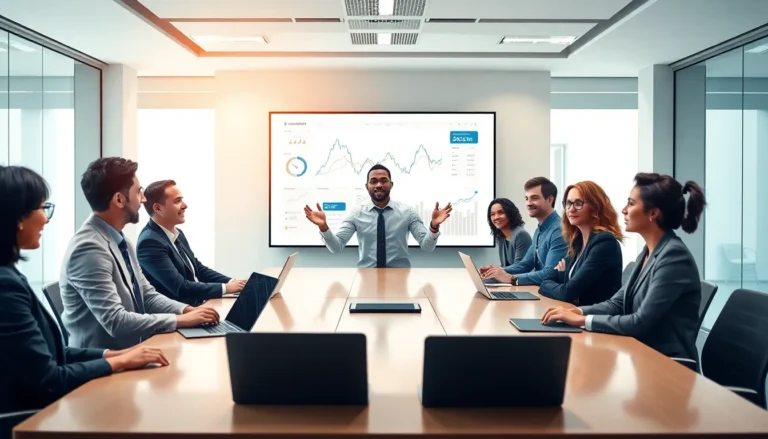Table of Contents
ToggleEffective communication is like a secret sauce. It can transform bland conversations into flavorful exchanges that leave everyone craving more. Whether in the boardroom or at a backyard barbecue, mastering the art of communication can elevate relationships and spark creativity. After all, who doesn’t want to be the person who can turn awkward silences into lively discussions?
Understanding Effective Communication
Effective communication encompasses the exchange of information that’s both clear and concise. It fosters understanding, builds relationships, and facilitates collaboration.
Definition of Effective Communication
Effective communication occurs when the intended message is conveyed clearly and accurately to the receiver. It includes verbal and nonverbal components, such as tone, body language, and active listening. Engaging in two-way communication allows individuals to express feelings and ideas while validating others’ viewpoints. Additionally, using appropriate language and adapting communication styles based on the audience enhances clarity and understanding. Ultimately, effective communication minimizes misunderstandings and promotes harmonious interactions.
Importance in Personal and Professional Life
Effective communication plays a vital role in both personal and professional settings. In personal life, it strengthens relationships by fostering trust and intimacy. Expressing thoughts openly encourages emotional connections and helps resolve conflicts. In professional environments, impactful communication improves teamwork and collaboration. Clear communication enhances productivity and goal achievement. In addition, effective communication skills can lead to better leadership and mentorship opportunities. Employees who communicate well contribute to a positive workplace culture and increased job satisfaction, ultimately benefiting the organization’s overall success.
Key Elements of Effective Communication

Effective communication comprises several key elements that enhance interactions. Mastering these components significantly improves understanding and fosters strong relationships.
Active Listening
Active listening plays a vital role in effective communication. Engaging fully with the speaker, they demonstrate attentiveness and respect. Clarifying questions also enhance understanding, ensuring the speaker feels heard. Reflecting on what is said shows appreciation for their message. Acknowledging emotions adds depth to the conversation, making exchanges more meaningful.
Clarity and Conciseness
Clarity and conciseness are essential for successful communication. Delivering messages in straightforward language prevents confusion among listeners. Using precise terms eliminates ambiguity, allowing for a clear exchange of ideas. Avoiding jargon facilitates understanding, especially with diverse audiences. Staying on topic keeps discussions focused, enabling effective collaboration.
Nonverbal Communication
Nonverbal communication influences how messages are received. Body language, facial expressions, and eye contact convey emotions and attitudes. Positive gestures, like nodding, encourage open dialogue, while crossed arms may signal defensiveness. Maintaining an approachable demeanor fosters trust among participants. In addition, consistent verbal and nonverbal cues enhance message reliability, promoting overall communication effectiveness.
Barriers to Effective Communication
Barriers often hinder effective communication. Identifying these obstacles can lead to improved interactions.
Common Misunderstandings
Misinterpretations often arise from ambiguous language and unfamiliar terms. Many individuals assume they understand each other, even when gaps in comprehension exist. Context plays a crucial role; messages lacking context are open to various interpretations. Vague statements may result in confusion, leading to frustration among participants. Clarifying intentions during discussions significantly reduces these misunderstandings. Ensuring alignment in terminology between speakers encourages clearer exchanges.
Emotional Barriers
Emotions frequently obstruct open communication. Anxiety or anger can distort perceptions and lead to miscommunication. Individuals preoccupied with their feelings may struggle to focus on the conversation. Vulnerability may deter honest expression when fear of judgment looms. Cultivating an empathetic atmosphere nurtures trust and encourages sharing thoughts. Being aware of emotional states fosters more productive dialogues. Acknowledging and addressing these feelings ultimately enhances communication effectiveness.
Strategies for Improving Effective Communication
Effective communication thrives on specific strategies designed to enhance understanding and foster relationships.
Developing Empathy
Cultivating empathy paves the way for connecting with others on a deeper level. Understanding others’ feelings and perspectives promotes stronger interactions. Practicing active listening encourages individuals to absorb what’s being communicated. This skill helps to decode emotional cues, making conversations more meaningful. Demonstrating genuine concern builds trust and encourages openness. Empathy also allows for better conflict resolution, as it enables individuals to respond thoughtfully rather than react defensively.
Using Feedback Constructively
Constructive feedback significantly improves communication efficacy. Providing specific insights encourages clarity in conversations. Tailoring feedback to the audience ensures it resonates, avoiding misunderstandings. Encouraging open discussions regarding feedback fosters a culture of collaboration. Clarity is key; using clear examples illustrates points effectively. Actively inviting feedback also helps individuals grow, promoting continuous improvement. Regularly incorporating feedback leads to more productive exchanges in both personal and professional settings.
Effective communication is a vital skill that can significantly impact relationships and interactions. By mastering the elements of clear expression and active listening, individuals can create more engaging and meaningful conversations.
Overcoming barriers and cultivating empathy enhances understanding and trust. Embracing constructive feedback not only improves communication but also fosters collaboration in various settings.
Striving for effective communication ultimately leads to stronger connections and a more positive environment, whether at work or in personal life. It’s an ongoing journey worth pursuing for anyone looking to elevate their interactions.







